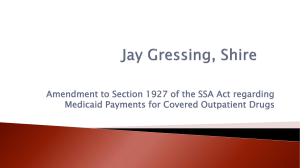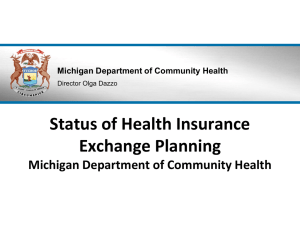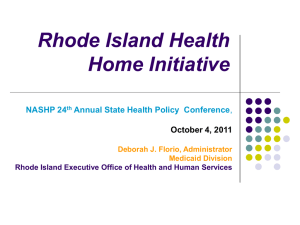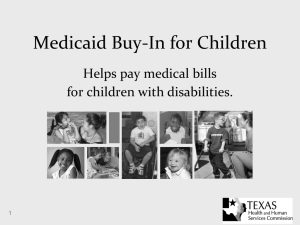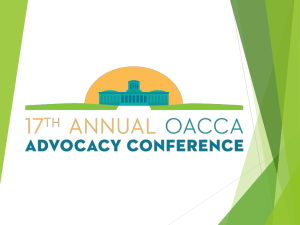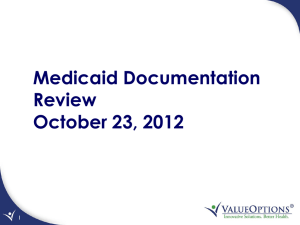Expedited Medicaid Restoration - Academic and Health Policy
advertisement
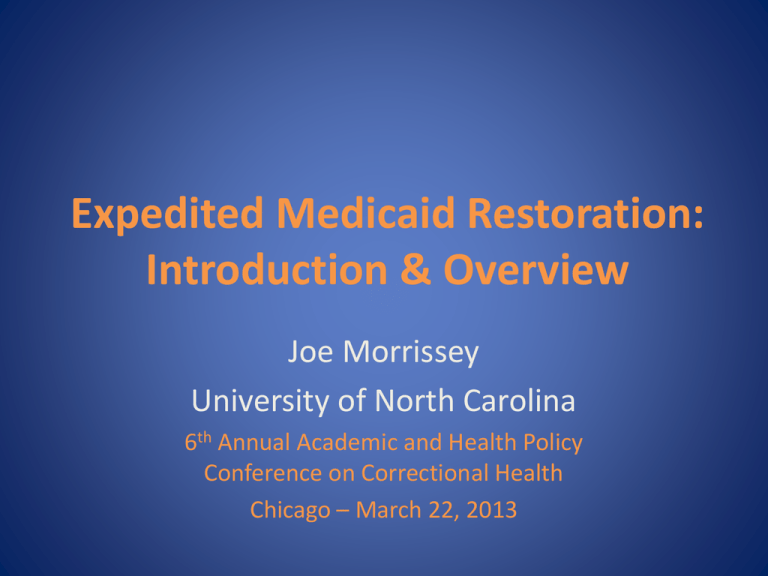
Expedited Medicaid Restoration: Introduction & Overview Joe Morrissey University of North Carolina 6th Annual Academic and Health Policy Conference on Correctional Health Chicago – March 22, 2013 Expediting Medicaid Benefits • Focus: Comparative costs of policies restoring Medicaid benefits prior to release from state prisons • Target Group: Persons with severe mental illness (SMI) • Study Sites: Washington and Connecticut 2 Acknowledgements • Funding • NIMH Research Grant “Community Reentry of Persons with Severe Mental Illness Released from State Prisons” (MH086232) • Assistance • 10 state agencies in WA and CT • Hsiu-Ju Lin, Connecticut Department of Mental Health & Addiction • • • • Services Shirley Richards and Jennifer Jolley, University of North Carolina at Chapel Hill Jeffrey Swanson and Allison Robertson, Duke University David Mancuso, Division of Research and Data Analysis, Washington State Department of Social and Health Services Colleen Gallagher and Dan Bannish, Connecticut Department of Correction 3 Seminar Presenters* 1. 2. 3. 4. Joe Morrissey – Introduction & Overview Linda Frisman – Outcomes in Connecticut Gary Cuddeback – Outcomes in Washington Marisa Domino – Cost Findings in Washington * No conflicts of interest to declare 4 Medicaid and Community Reentry • Medicaid is the single largest payer of mental health services for persons w SMI in the US today – Council of State Government suggests Medicaid is critical to successful community reentry – Without sustaining health & welfare benefits justiceinvolved persons with mental illness will be unable to “break the cycle of recidivism” (Bazelon Center) • Federal regulations require suspension or termination of Medicaid benefits after 30 days of incarceration or hospitalization • A number of states have introduced policies to expedite the restoration of Medicaid benefits prior to release from prison and other institutions 5 What’s the Evidence Base for Expedited Medicaid? • Wenzlow et al. (2011) small study (N= 77) of expedited Medicaid in 3 Oklahoma prisons – Increased Medicaid enrollment on day of release by 15 percentage points vs. controls (p=.012) – Increased Medicaid mental health service use by 16 percentage points (p=.009) vs. controls at 90 days post release • Morrissey, Cuddeback et al. (2006, 2007) showed that persons w SMI in jail with Medicaid at release had: – Quicker service access & more community service use (p<.001) – Fewer re-arrests, more days in community (p<.01) • To date, no comparative study of prison re-entry nationally or in different states, no studies with large sample sizes 6 Current Study • Response to NIMH solicitation in 2008 for use of administrative data to address state-level behavioral health policies • NIMH required comparison of at least two states • Assembled a research team from UNC, CTDMHAS, and Duke that had prior experiences using administrative data to address state policy issues in Washington & Connecticut 7 Expedited Medicaid • Policy start date – Connecticut: April 2005 – Washington: January 2006 • Benefits affected by restoration – Federal Medicaid via SSI/SSDI eligibility » (i.e., Aged, Blind, Disabled) – State Medicaid, a less generous benefit often used as an initial or transitional status pending Federal Medicaid restoration » SAGA in Connecticut » GAU in Washington 8 Policy Implementation Connecticut in 2005 • DOC only • Discharge Planners (6) working for Correctional Managed Health Care & based in correctional facilities complete paperwork to apply for Medicaid prior to release & fax to state Medicaid agency • Entitlement specialists (2) based at state Medicaid agency process applications • Daily e-feed of population list results in benefits being “switched on” Washington in 2006 • DOC, jails, state hospitals • Two step process ① Referral: DOC staff identified inmates and prepared applications prior to release ② Approval: Following release, inmate had to appear at local Community Service Office to activate application • Legislature funded and distributed 14 FTE Community Service Officers statewide to prioritize expedited cases 9 Other Differences b/w States Connecticut Washington • Unitary corrections system: State DOC operates prisons and jails • Much of Medicaid was fee-forservice in the study period • State Administered General Assistance (SAGA) covered services at a similar rate • Virtually no one is denied benefits • Even prisoners not expedited had 2-4 weeks of Rx at the time of discharge • Dual corrections system: State DOC operates prisons and County Sheriffs operate jails • Medicaid managed care with HMO for medical care and carve-outs for behavioral health care • Federal Medicaid required for access to specialty mental health services • State Medicaid (GAU) covers meds from primary care MDs 10 Research Design • Case-control study with data available 3-yrs. pre and 3-yrs.post start of expedited Medicaid policy • Administrative data on inmates with SMI, service contacts for mental health (inpatient & outpatient), substance use, arrests & incarcerations • Propensity score analysis used to construct comparison group of inmates with SMI who were not expedited and released during same time period 11 Core Analysis for Inmates w SMI Released from CT & WA Prisons Usual Release * Release w/ Expedited Medicaid * 12-mo postrelease service use and costs 12-mo postrelease service use and costs 12-mo arrest and incarceration 12-mo arrest and incarceration * Comparison groups matched on propensity scores created from demographics, clinical diagnoses, and behavioral health/criminal justice history for the 3-yrs. prior to an index release 12 Expedited Medicaid Restoration in Connecticut Linda Frisman CT DMHAS and UConn SSW 6th Annual Academic and Health Policy Conference on Correctional Health Chicago – March 22, 2013 Methods for CT Data • Started with DOC discharges w/ 1 year FU • Experimental group defined by DSS • Propensity Scoring – 1,511 Pre-Release Entitlement (PRE) = E – 1,511 Propensity-matched cases (Non-PRE) = C • Survival Analysis (Cox Regression) – Time to event (enrollment, OP Tx, IP, arrest, etc) • Poisson Models for count data 14 Poisson Models • Used in a “conditional” situation: e.g., rate of use of EDs & # visits – First part is about the likelihood of the situation happening – Second part is the count of the event • Poisson models involve different assumptions – Poisson regression: • assumes equally dispersion (the conditional variance equals the conditional mean) – Negative binomial regression (NB): • allows for over-dispersion – Zero inflated Poisson model (ZIP): • allows for excess zeros – Zero inflated Poisson negative binomial regression (ZINB): • allows for over-dispersion and excess zeros • Need to use the model best-suited to the data 15 Propensity-Matched Groups (1) Prior to matching, all were significantly different Variable PRE Group Non-PRE Male 1148 (76.0%) 1180 (78.1%) 0.166 Age @ release 37.81 (10.57) 37.41 (11.04) 0.307 White 712 (47.1%) 687 (45.5%) Black 459 (30.4%) 471 (31.2%) Hispanic 337 (22.3%) 342 (22.6%) 48 (3.2%) 78 (5.2%) Released 2006 Released 2007 562 (37.2%) 626 (41.4%) Released 2008 901 (59.6%) 807 (53.4%) Prob. 0.157 .000*** 16 Propensity-Matched Groups (2) Prior to match, all were sig. different except crime severity Variable PRE Group Non-PRE Prob. Prior SSI DMHAS history 320 (21.2%) 357 (23.6%) 0.106 1285 (85.0%) 1295 (85.7%) 0.607 Incarceration days Overall RISK MH SA Medical Crime severity Violence Discipline Gang 389.9 (586.3) 2.50 (0.97) 2.52 (0.87) 3.02 (1.14) 2.23 (0.89) 2.03 (1.10) 1.71 (0.91) 1.44 (0.95) 1.14 (0.53) 402.52 (807.4) 2.52 (1.01) 2.59 (1.08) 3.05 (1.10) 2.28 (0.93) 2.10 (1.08) 1.74 (0.93) 1.34 (0.85) 1.08 (0.35) 0.623 0.685 0.046* 0.485 0.186 0.074 0.353 0.004** 0.000*** 17 Health Outcomes, 12 months Variable PRE Group Non-PRE On Medicaid 1328 (87.9%) 959 (63.5%) 0.000*** Days to Medicaid 6.11 (30.08) 38.88 (81.13) 0.000*** Any IP admit 518 (34.3%) 475 (31.4%) 0.096 Days IP 50.69 (86.75) 59.72 (100.15) 0.008** Days to 1st IP 116.49 (104.26) 108.56 (107.11) 0.238 Any OP claims 1269 (84.0%) 971 (64.3%) 0.000*** # OP claims 57.53 (77.61) 41.93 (75.39) 0.000*** Days to 1st OP visits 42.85 (67.61) 71.22 (86.74) 0.000*** Any ED/crisis 265 (17.5%) 202 (13.4%) 0.002** 0.24 (0.63) 130.44 (108.17) 305.41 (90.02) 0.20 (0.71) 132.80 (107.56) 297.22 (98.78) 0.129 0.815 0.017* # ED/crisis Days to 1st ED/crisis Community Days Prob. 18 Criminal Justice Outcomes, 12 months Variable PRE Group Non-PRE Prob. % re-arrested 515 (34.1%) 495 (32.8%) 0.441 # arrests 0.50 (0.84) 0.49 (0.87) 0.701 Days to 1st re-arrest 136.3 (115.7) 137.10 (108.52) 0.079 % re-incarcerated 592 (39.2%) 615 (40.7%) 0.393 Days incarcerated 49.24 (85.49) 51.52 (88.96) 0.474 Time to 1st re-incarceration 157.48 (99.23) 144.86 (102.62) 0.030* 19 Cox Regression DV: Time to… IV/Covars OR (SE) Prob. Medicaid Enroll. PRE 1.63 (0.045) <0.000*** Inpatient Hosp. PRE 1.09 (0.064) 0.175 Incarceration days 0.99 (0.00) 0.010* NH days 1.004 (0.001) 0.001** Outpatient Service PRE Community days 1.89 (0.043) 1.00 (0.00) <0.000*** 0.262 ER/Crisis PRE Community days PRE Community days PRE IP days NH days 1.37 (0.094) 0.99 (0.000) 1.11 (0.06) 0.99 (0.00) 0.93 (0.06) 0.99 (0.001) 0.99 (0.005) 0.001** 0.027* 0.079 <0.000*** 0.190 0.067 0.153 Re-arrest Re-incarceration 20 Survival to Medicaid Enrollment 21 Survival to First OP Visit 22 Negative Binomial DV Inpatient Hosp. Days Outpatient Services Incarceration Days IV/Covars OR (SE) Prob. PRE -0.52 (0.13) 0.0001*** Incarceration days -0.003 (0.0007) 0.0001*** NH days 0.005 (0.006) 0.4533 PRE 0.305 (0.065) 0.0001*** Community days 0.001 (0.0004) 0.0073** PRE -0.06 (0.12) 0.6005 IP days -0.01 (0.001) 0.0042** -0.001 (0.004) 0.0207* NH days 23 ZINB results for re-arrest Estimate SE t P value Count Intercept 0.784559 0.090457 8.67 <.0001 PRE 0.046296 0.059419 0.78 0.4359 -0.005321 0.000296 -17.98 <.0001 Intercept 1.332494 0.508800 2.62 0.0088 PRE 0.523669 0.994969 0.53 0.5987 -0.104144 0.040395 -2.58 0.0099 0.483689 0.072091 6.71 <.0001 Community Days Probability Community Days Alpha 24 ZINB results for ED/Crisis Estimate SE t P value Count Intercept -0.365080 0.290971 -1.25 0.2096 PRE 0.063935 0.105793 0.60 0.5456 Community days -0.003667 0.000845 -4.34 <.0001 Intercept 3.013739 0.751414 4.01 <.0001 PRE -1.817098 0.791286 -2.30 0.0217 Community Days -0.025838 0.007342 -3.52 0.0004 Alpha 2.730451 0.331622 8.23 <.0001 Probability 25 Summary of CT Findings • In Connecticut, the Pre-Release Enrollment Program resulted in: – Quicker access to Medicaid – Quicker use & more use of Outpatient services – Reduced use of Inpatient Care – More community days – NS difference in # of visits to EDs/crisis overall – BUT people in PRE were more likely to use EDs – No difference in CJ outcomes 26 Expedited Medicaid Restoration in Washington State Gary Cuddeback and Jennifer Jolley University of North Carolina 6th Annual Academic and Health Policy Conference on Correctional Health Chicago – March 22, 2013 Research Question & Methods • What is the impact of an expedited Medicaid restoration program for SMI persons released from prison in Washington State? • Quasi-experimental design w/PSM – Individuals with SMI released from prison in 2006 or 2007 • Approved for expedited Medicaid restoration vs. those who were referred but not approved or eligible but not referred – 12-month follow-up after index release in 2006 or 2007 28 Definitions and Data • Severe mental illness defined as having a diagnosis of schizophrenia or other psychotic disorders and/or bipolar disorder (with some exceptions) – Dx came from community mental health or DOC • Linked administrative data available from 2003 to 2010 from Washington State CODB – Demographics, diagnoses, Medicaid (program type), inpatient and outpatient mental health service use, substance use service use, homelessness, employment, arrests, jail (some), violator facilities, prisons – Linked at person-level to create longitudinal file 29 Data Analysis • Regression and survival models with PSM weights and robust standard errors • HB1290 approval = independent variable • Dependent variables … – Logistic regression • Probability of Medicaid • Probability of outpatient service • Probability of arrest – OLS and survival models • Time to Medicaid • Time to first service • Time to arrest • PSM balanced groups on all observables (more later) 30 Sample Characteristics: Approved, Denied and Not Referred Approved (658) % (n) Denied* (258) % (n) Male White Age (M(SD)) 77 (504) 69 (451) 36 (8.9) 73 (189) 73 (189) 37 (11.9) Psychotic disorder SMI/SA Prior ABD Medicaid 60 (395) 90 (594) 79 (517) 48 (123) 84 (217) 40 (104) Prior GAU Medicaid 30 (197) 21 (55) Not Referred (2538) % (n) 73 (1823) 73 (1823) 36 (9.5) 40 (1020) 80 (2010) 27 (683) 16 (403) * Note: Denial reasons included: living arrangement (32%), failed incapacity requirement (26%), voluntary withdrawal (6%), and other reasons (46%) 31 12-mo. Post-release Outcomes Homeless Unemployed Medicaid (ABD) Medicaid (GAU) Any MH outpatient svc Any AOD outpatient svc Anti-psychotic meds Anti-depress meds Any inpatient service Arrest Approved Denied Not Referred % (n) 56 (339) % (n) 67 (161) % (n) 60 (1407) 86 (523) 93 (568) 30 (181) 82 (198) 63 (153) 52 (120) 70 (1645) 47 (1102) 48 (1070) 22 (132) 43 (275) 49 (309) 48 (306) 12 (28) 33 (83) 28 (71) 32 (81) 7 (161) 32 (777) 15 (371) 21 (495) 10 (63) 7 (16) 4 (96) 56 (338) 60 (144) 51 (1186) 32 12-mo. Post-release Outcomes* Outcome Coeff (SE) Probability of ABD Medicaid 2.35 (.18) .001 +39% Probability of GAU Medicaid -.12 (.11) Probability of other Medicaid -.76 (.14) .001 -13% Probability of outpatient service 1.16(.14) .001 +14% Probability of inpatient admit .62 (.18) ns Probability of arrest .11 (.11) ns Probability of incarceration -.05 (.18) ns * Logistic regression with PSM weights used p +/- ns 33 12-mo. Post-release Outcomes (cont’d) Outcome Coeff (SE) p Time to GAU Medicaid 8.9 (7.2) ns Time to other Medicaid 38.4 (5.7) .01 Time to outpatient service -34.5 (5.3) .001 -34.5 Time to inpatient admit -.22 (.58) ns Time to arrest -7.5 (6.6) ns Time to incarceration (prison) 7.3 (3.6) .05 Time to ABD Medicaid +/days -115.5 (6.53) .01 -115.5 +38.4 +7.3 34 LR w/o PSM: Probability of Arrest Indicator Coeff (SE) p OR Male .37 (.04) .001 2.01 Race .20 (.07) .001 1.42 Age -.54 (.07) .01 .33 Homelessness .26 (.04) .001 1.69 Unemployment .40 (.04) .001 2.21 Substance use disorder .19 .001 1.47 Expedited Medicaid .03 ns 35 Key Findings • Expedited benefit restoration associated with – Greater and quicker Medicaid uptake – Greater and quicker access to outpatient mental health services • Restored benefits not associated with lower probability of criminal justice events – Some improvement in time in community until prison • Expedited restoration is working as a health insurance program but few spill-overs for corrections • But Medicaid alone is not enough as evidenced by role of substance use, homelessness and unemployment in arrest & re-incarceration! 36 Expedited Medicaid Restoration in Washington State: Cost-Effectiveness Marisa Domino and Jennifer Jolley University of North Carolina 6th Annual Academic and Health Policy Conference on Correctional Health Chicago – March 22, 2013 Cost Analysis • We examined the cost of expedited Medicaid using a government payer perspective – Costs related to medical and mental health services use and criminal justice costs were included – Short-run (12 month) time period examined • We also analyzed days in the community as a measure of effectiveness, for a cost-effectiveness calculation – Days not incarcerated nor in inpatient settings 38 Cost Methods • Costs of medical and mental health services used actual payments by Medicaid, state, and regional payers for services delivered • State hospital days costed using per diems • Services include: – Outpatient medical and mental health services – Inpatient services, including state hospitals and local inpatient hospitals – Emergency room, crisis treatment, and medications 39 Cost Methods, continued • Criminal justice costs used Washington State Institute for Public Policy (WSIPP) calculated costs, including costs of: – Arrests – Jail – Prison – Parole 40 Analysis Methods • Because of concerns over selection bias in that those receiving expedited Medicaid may differ from those not receiving expedited Medicaid, we used propensity score weighting to obtain better balance on baseline risk factors • Baseline risk factors include: time in prison and jail, year of release, race/ethnicity, age, gender, prior history of mental health service use, homeless prior to index incarceration, work history, and Medicaid/state program enrollment prior to index incarceration • All factors balanced after propensity weighting <=.25 SD/mean difference in groups 41 Selected Baseline Risk Factors Weighted mean – Expedited (n=608) Weight mean – Controls (n=2554) 531 513 Minority 41.0% 39.5% Latino 6.1% 6.3% Age 35 34 Male 75% 74% Psychotic disorder 45% 45% 58 58 Homeless prior 51% 52% Work history 59% 60% Variable Time served (days) Jail days prior 42 Cost Results Cost type Weighted difference between Expedited and Controls Total cost $3437** Antipsychotic medications $672** Inpatient/ER- medical $590 (p=0.051) Arrests $559 (p=0.095) OP medical $533** ER $357** AOD $258** Parole -$22* Prison costs (DOC) -$398 (p=0.067) **p<0.01; *p<0.05 43 Community Days • We find approximately 5 more community days (p=0.076) in 12 months for those on expedited Medicaid • 3437/5 ~ $687/community day 44 Conclusions • Preliminary results indicate that Expediting Medicaid increases access to services, thus increasing costs in the short run (1 year) • While the program results in a greater number of community days, this amounts to a relatively high cost per day ($687) in the short run 45 Conclusions/Limitations • If investments in health are made in the short run, the payoff in terms of reductions in hospitalizations may not be observed until beyond the 12 month window – 36 month analysis is pending; will also look at – 30 and 90 day results re criminal justice outcomes • Days in the community is a crude measure, which does not reflect quality of life – Clinical and person-centered measures are not available in our data 46 Conclusions • In summary, expedited Medicaid in Washington State led to: – shorter time without insurance coverage – Better access to services, especially pharmaceuticals – Higher costs, in total and on most dimensions – A few more days in the community post-index release – Slight but nonsignificant reduction in DOC costs 47 Comparisons & Implications • In both states, expedited Medicaid restoration led to quicker and greater mental health service use • No strong effects re reduced criminal justice outcomes & costs • Many controls went on to obtain Medicaid after release so further analyses are needed to isolate overall effects of having vs. not-having Medicaid • However, our current analyses suggest that Medicaid alone might not be enough to keep people with SMI out of criminal justice system 48 Contacts For additional questions and copies of our presentation, please contact us: • Joe Morrissey – joe_morrissey@unc.edu • Linda Frisman – lfrisman@ct.gov • Marisa Domino – domino@unc.edu • Gary Cuddeback – gcuddeba@email.unc.edu 49

